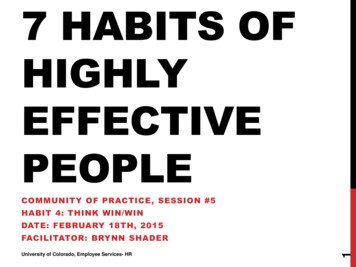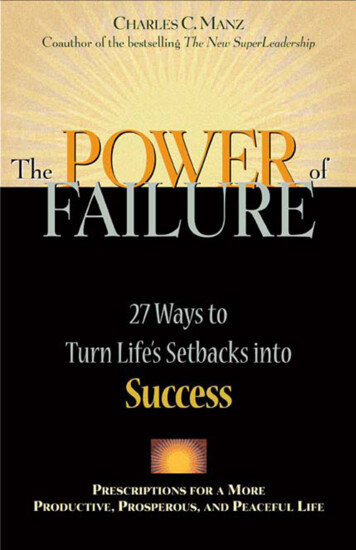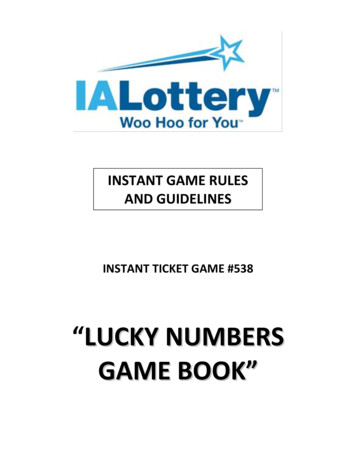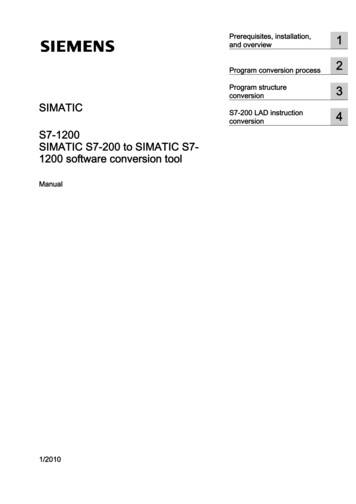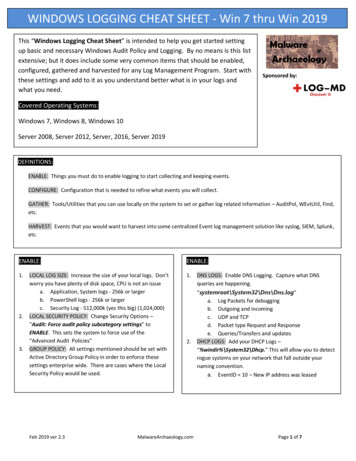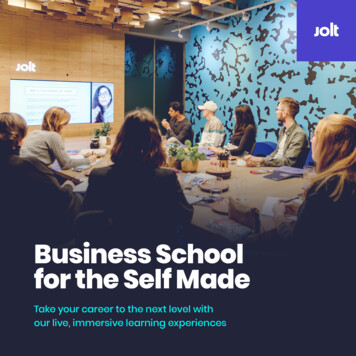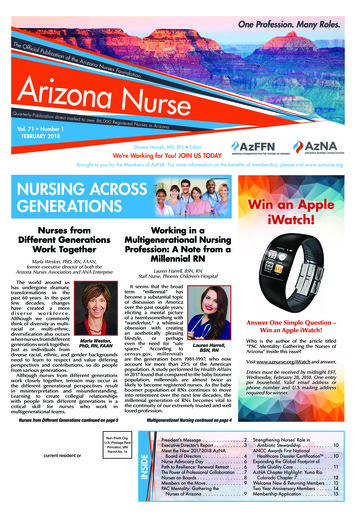
Transcription
One Profession. Many Roles.The OfficialPublicationoft he ArizonaNurses FoundationArizona NurseQuarterly Publication directmailed to over86,000 Registered Nurses inArizonaVol. 71 Number 1FEBRUARY 2018Shawn Harrell, MS, RN EditorWe’re Working for You! JOIN US TODAYBrought to you by the Members of AzNA. For more information on the benefits of membership, please visit www.aznurse.org.NURSING ACROSSGENERATIONSNurses fromDifferent GenerationsWork TogetherMarla Weston, PhD, RN, FAAN,former executive director of both theArizona Nurses Association and ANA EnterpriseWorking in aMultigenerational NursingProfession: A Note from aMillennial RNLauren Harrell, BSN, RNStaff Nurse, Phoenix Children’s HospitalThe world around ushas undergone dramatictransformations in thepast 60 years. In the pastfew decades, changeshave created a morediverse workforce.Although we commonlythink of diversity as multiracial or multi-ethnic,diversification also occurswhen nurses from differentMarla Weston,generations work together.PhD, RN, FAANJust as individuals fromdiverse racial, ethnic, and gender backgroundsneed to learn to respect and value differingperspectives and contributions, so do peoplefrom various generations.Although nurses from different generationswork closely together, tension may occur asthe different generational perspectives resultin misinterpretation and misunderstanding.Learning to create collegial relationshipswith people from different generations is acritical skill for nurses who work inmultigenerational teams.It seems that the broadterm“millennial”hasbecome a substantial topicof discussion in Americaover the past couple years,eliciting a mental pictureof a twentysomething with“wanderlust,” a whimsicalobsession with creatingan aesthetically pleasinglifestyle,orperhapseven the need for “safeLauren Harrell,spaces.”AccordingtoBSN, RNcensus.gov, millennialsare the generation born 1981-1997, who nowaccount for more than 25% of the Americanpopulation. A study performed by Health Affairsin 2017 found that compared to the baby boomerpopulation, millennials are almost twice aslikely to become registered nurses. As the babyboomer population of RNs continues to moveinto retirement over the next few decades, themillennial generation of RNs becomes vital tothe continuity of our extremely trusted and wellloved profession.Nurses from Different Generations continued on page 5Multigenerational Nursing continued on page 4Non-Profit Org.U.S. Postage PaidPrinceton, MNPermit No. 14INSIDEcurrent resident orWin an AppleiWatch!President's Message . . . . . . . . . . . . . . .Executive Director’s Report. . . . . . . . . . .Meet the New 2017-2018 AzNABoard of Directors . . . . . . . . . . . . . . .Nurse Advocacy Day . . . . . . . . . . . . . .Path to Resilience: Renewal Retreat . . . . .The Power of Professional Collaboration . . .Nurses on Boards. . . . . . . . . . . . . . . . .Members on the Move. . . . . . . . . . . . . .PAC Mentality: Gathering theNurses of Arizona . . . . . . . . . . . . . . .Answer One Simple Question –Win an Apple iWatch!Who is the author of the article titled“PAC Mentality: Gathering the Nurses ofArizona” inside this issue?Visit www.aznurse.org/iWatch and answer.Entries must be received by midnight EST,Wednesday, February 28, 2018. One entryper household. Valid email address orphone number and U.S mailing addressrequired for winner.234667899Strengthening Nurses’ Role inAntibiotic Stewardship . . . . . . . . . . . 10ANCC Awards First NationalHealthcare Disaster CertificationTM . . . 10Expanding the Global Footprint ofSafe Quality Care . . . . . . . . . . . . . . . 11AzNA Chapter Highlight: Yuma RioColorado Chapter 7. . . . . . . . . . . . . . 12Welcome New & Returning Members . . . 13Two Year Anniversary Members. . . . . . 14Membership Application . . . . . . . . . . . . 15
Page 2 Arizona NurseFebruary, March, April 2018PRESIDENT’S MESSAGEThe Power of OneNo one is too small tomake a difference. Greatinitiatives have been knownto start with one person.They usually start with anidea or conviction and anindividual who makes adifference.Take for example NevaFarmer. I had the privilege ofhearing Neva and ProfessorMisty Marshall speak at theSelina Bliss,Student Nurses AssociationRN, PhD, CNE,RN-BCof Arizona (SNAAz) on thetopic of engaging studentsin leadership development in and outside of theclassroom. What I learned was that while a nursingstudent at Scottsdale Community College, Nevanoticed there was not a student nurses associationfor her to join. Neva contacted her professor MistyMarshall who, along with Neva, inspired faculty andcolleagues to begin a student nurses association(SNA). Neva is now a graduate, active in the ArizonaNurses Association (AzNA) while the ScottsdaleCommunity College has an active SNA of 50 plusmembers. The strength of association begins withone and Nurse Neva has set an excellent example.Neva Farmer with her Professor Misty Marshall,MS, RN at her pinning ceremony at ScottsdaleCommunity CollegeAnother nurse who is making a difference isAlex Wubbel, the nurse from Utah who was avictim of abuse and wrongful arrest last year nowJOIN A GREAT TEAMValley Hospital is a private freestandingpsychiatric hospital specializing in mental healthand chemical dependency care.Valley Hospital is currently recruiting for aFull-Time experienced night shift RegisteredNurses. Previous experience as a Behavior HealthRN preferred. Valley Hospital offers a competitivesalary and a generous benefit package.3550 East Pinchot Ave., Phoenix, AZ 85018For more information or to apply, visit:www.valleyhospital-phoenix.comor call 602-952-3904speaks about ending nurse abuse in healthcare.In response to her story, and the many otherstories of nurse abuse we see in the news, theAmerican Nurses Association (ANA) is launching apledge you can sign to help end abuse in America(found on Twitter at #EndNurseAbuse or on theANA website at http://p2a.co/japlwMm). Thiscampaign that Nurse Alex has started seeks toreduce nurse abuse by promoting the reportingof incidences of violence and abuse within healthcare, strengthening a “zero tolerance” policy forviolence, reduction and security procedures andpolicies to increase deterrence, support prevention,and increase response to incidences of violenceand abuse. Signing the pledge means supportingzero tolerance policies for abuse against nurses,reporting abuse when it’s witnessed, and askingothers to sign the pledge as well. At the time ofthis writing, there are more than 6,000 signers whohave taken the pledge. And to think, bringing thismovement forward to the public was started byone person!Making a difference in healthcare means beinginvolved in advocacy and public policy. Did youknow that among the 60 members of the ArizonaHouse of Representatives and the 30 ArizonaSenators, only 2 are healthcare professionals? Ofthose two healthcare professionals, neither is anurse. The Arizona Legislature passes laws thatdirectly affect the nursing profession and patientcare, yet do they realize what a nurse does?! That iswhere we come in to help provide the backgroundand knowledge needed for our legislators to craftbills that affect healthcare. We all know that nursesspend each day educating patients and familiesabout disease processes, treatment options, anddischarge plans, so why not use our expertiseto educate our legislators. With over 86,000licensed registered nurses in the state of Arizona,we have the unique opportunity to advocate forour profession, patient safety, and the future ofhealthcare. If nursing is not at the table whendecisions are made, the voice of nursing will neverbe heard.How can you take advocacy to the next level byinvolvement at the state level? The AzNA makesit easy by providing the means to be involved inpublic policy using three different ways in whichmembers can get involved. First, as a nurse youhave the opportunity to participate in public policyby joining the AzNA Public Policy Committee.This is an exciting time of year as the 2018 SecondSession of the Fifty Third Arizona State Legislature isstarting. Denice Gibson is the AzNA GovernmentalAffairs Officer and is coordinating the AzNAPublic Policy Committee. On this committee, shewill walk you through reviewing bills in the areaof your interest where you can recommend if weshould support, monitor, or oppose and why. If youare interested in providing input in the legislativeprocess, contact Denice at denice.gibson@gmail.com and she will get you started.The second method by which you couldparticipate in public policy across the state isby getting involved in the AzNA Political ActionCommittee (AzNA-PAC). The purpose of thePresident’s Message continued on page 3www.aznurse.orgEqual Opportunity EmployerPublished by:Arthur L. DavisPublishing Agency, Inc.ChairRhonda Anderson, DNSc, RN, FAAN, FACHEVice ChairPat Mews, MHA, RN, CNORTreasurerMelissa HuckinsSecretaryChloe Littzen, BSN, RNScholarship ChairSharon Rayman, MS, RN, CCTC, CPTCElected TrusteeCarol Stevens, PhD, RNElected TrusteeKimberly Behrens-GrieserElected TrusteeJeff CoxElected TrusteePhillip GuarreraExecutive DirectorRobin Schaeffer, MSN, RN, CAEBoard of DirectorsPresidentSelina Bliss, PhD, RN, CNE, RN-BCVice PresidentCharlotte Russell, MSN, RN, FNE, CLLSecretaryDavid Hrabe, PhD, RN, NC-BCTreasurerHolly Carlson, MS, RN, CCRNGovernment Affairs OfficerDenice Gibson, DNP, RN, CRNI, BMTCN, AOCNSPast PresidentCarol J. Stevens, PhD, RNStaffRobin Schaeffer, MSN, RN, CAE,Executive DirectorDebby Wood, Office ManagerWendy Knefelkamp, Communications ManagerDebbie Blanchard, Administrative AssistantThe Arizona Nurse (ISSN 0004-1599) is the officialpublication of the Arizona Nurses Foundation (AzNF) publishedquarterly by AzNF, peer reviewed and indexed in CumulativeIndex for Nursing and Allied Health Literature. Arizona NurseAuthor Guidelines are available at www.aznurse.org. Call480.831.0404 or info@aznurse.org for more information.No material in the newsletter may be reproducedwithout written permission from the Executive Director.Subscription price: included in AzNA membership or 30 per year. The purpose of the Arizona Nurse is tocommunicate with AzNA members and non-members inorder to 1) advance and promote professional nursing inArizona, 2) disseminate information and encourage inputand feedback on relevant nursing issues, 3) stimulateinterest and participation in AzNA and 4) share informationabout AzNA activities.For advertising rates and information, please contactArthur L. Davis Publishing Agency, Inc., 517 WashingtonStreet, PO Box 216, Cedar Falls, Iowa 50613, (800) 626-4081,sales@aldpub.com. Responsibility for errors in advertisingis limited to corrections in the next issue or refund of priceof advertisement.Advertisements do not imply endorsement norapproval by the Arizona Nurses Foundation (AzNF) ofthe product advertised, the advertisers or the claimsmade. AzNF shall not be held liable for any consequencesresulting from the purchase or use of advertised projects.AzNF, AzNA and Arthur L. Davis Publishing Agency, Inc.reserve the right to reject advertisements. Rejection of anadvertisement does not imply that the offering or productfor advertisement is without merit, lacks integrity, or thatthis association disapproves of the offering or product.The Arizona Nurses Association is a constituentmember of the American Nurses Association.
February, March, April 2018Arizona Nurse Page 3EXECUTIVE DIRECTOR’S REPORTAre You Wearing Your Badge of Pride?Robin Schaeffer, MSN, RN, CAEExecutive DirectorI don’t know about you,but I couldn’t be morepassionate or prouder to bea nurse and wear my Badgeof Pride every day. It iscomforting to know that aswe travel through changesin our nursing careers (newgrad, new job, advanceddegree, etc) that there isa consistent and familiarplace that we can call home,Robin Schaeffer,our professional home thatMSN, RN, CAEis. A place where our Badgeof Pride resides!So, what exactly is the Badge of Pride andhow does one acquire it? It is a cost-effectivemembership in the largest and most recognizednursing organization in Arizona: The Arizona NursesAssociation (AzNA). Joining AzNA automaticallymakes you a member of the state, your localgeographic chapter AND a member of the nationalAmerican Nurses Association (ANA). That’s 3 levelsof membership for just 15/month! Membershipshows commitment to your profession andsupports state-based work that affects your joband your career. The Badge of Pride is somethingthat looks a bit different on each nurse. After all,with over 86,000 RNs in Arizona, diversity is one ofPresident’s Message continued from page 2AzNA-PAC is to endorse candidates for the ArizonaLegislature based upon the principles of the AzNAPublic Policy Agenda. The AzNA-PAC encouragesnurses to become active and effective in shapingpublic policy through the electoral process.The AzNA-PAC raises funds to endorse politicalcandidates that support the nursing profession.The AzNA-PAC further evaluates, endorses, andcontributes to candidates for the State Legislaturein Arizona who have clearly demonstratedresponsible awareness of nurses’ needs. You canbe an ambassador from your legislative district. Formore information visit the AzNA website.Finally, you can participate in public policy byjoining AzNA at Nurse Advocacy Day February8th. During this event you will learn of the crucialrole nurses play in health care policy decisions andrecognize the ability of individual nurses to applythe keys to association engagement and success.Here are some of main reasons why so many ofyou are already members and why, if you are not amember you will want to join and wear your Badgeof Pride;Advance your Career As one member stated “I attended the annualAzNA convention and sat next to a nurseleader from a hospital where I wanted towork. She helped me get an interview and Iwas hired!” Attend local and national conferences at adiscounted rate Sit on local boards and committees Attend free webinars ANCC certification discounts Attend leadership coursesStay Current with these publications Arizona Nurse and American Nurse Today OJIN – Online Journal of Nursing Issues (peerreviewed) Foundation of Nursing (Code of Ethics, SocialPolicy Statement) Professional Tools: CINAHL, Drug Name ErrorFinder Tool, PubMed CitationsInfluence decisions that impact nurses at the stateand national level It’s all about using your voice. Meeting withArizona representatives and senators at ourtheir patient advocacy skills to public policy andpolitical action. Our AzNA lobbyists will be thereto coach us on advocacy strategies. You will alsohave an opportunity to hear about current andfuture legislation that will impact us in our nursingpractice as well as the health of Arizonans. After weform groups by legislative districts, we will makeplans to follow up with our legislators to speakabout current legislation. I remember fondly myfirst day at the legislature, when we met with ourlocal representative. I was surprised at how muchour representatives want to hear and know fromus. At the time, my legislator was asking our groupseveral questions about the role of the school nurseand how adult group rehabilitation homes areregulated. We know now several bills were passedin regards to these important issues. Last year AzNAand the Arizona Coalition of Advanced PracticeNurses led efforts to empower advanced practicenurses through an expanded scope of practice thusstate Capitol continues to be one of the mostpowerful experiences that our nurses haveyear after year. One nurse stated: “This wassuch an awesome experience; it made merealize there is more to nursing than just 12hour shifts.” February 8th is our RN AdvocacyDay. See page 6 and visit www.aznurse.org tosign up. Also, did you know that nurses fromANA are on Capitol Hill regularly where issueslike safe nurse staffing are being addressedwith members of congress?Save Money Discounts on ANA-published books Protect yourself with ANA personal benefits:Professional Liability, Financial Planning, AutoInsurance and more Priceless has a price and this one is only 15a month! Visit the AzNA (www.aznurse.org)and ANA (www.nursingworld.org) websitesto learn about the work of nursing on thelocal and national level. Membership processis online or printed on page 15.Thank you for choosing our great profession ofnursing. Thank you to our thousands of AZ nurseswho are already AzNA/ANA members. To thosethat are not members, thank you for reading thisarticle; there is nothing I would like more than tosee your name on our next new member list.-Robinimproving patient access to safe quality affordablecare. It boils down to our Mission statement thatis to advance the nursing profession and promotea healthy Arizona. If we don’t advocate for ourprofession, who will?Think about how you can be involved in shapingnursing practice in Arizona. After all, making adifference starts with one person. It can start withyou.I hope to see you out there –Selina BlissPresident - AzNATOHONO O’ODHAM NATION HEALTHCARECall for Article SubmissionSubmit your article or research for publication in AzNA’s quarterly print publication.The Arizona Nurse is mailed to all 86,000 RNs in the state.AzNA welcomes submission of nursing and health related news items and original articles.We encourage short summaries and brief abstracts for research or scholarly contributionswith an emphasis on application.To promote inclusion of submitted articles, please review the Article guidelines available onthe AzNA website at www.aznurse.org/Guidelines.An “article for reprint” may be considered if accompanied by written permission from theauthor and/or publisher as needed. Authors do not need to be AzNA members.Submission of articles constitutes agreement to allow changes made by editorial staff andpublishers. See Article Guidelines for more information.Submit your article to info@aznurse.org.IS NOW RECRUITING!SELLS HOSPITAL – SELLS, AZ: Practical Nurse Nurse Specialist/Case Manager Clinical Nurse/Emergency Care Medical Instrument Technician Medical Laboratory TechnicianNurse PractitionerPublic Health NurseClinical Nurse/Ambulatory CareSAN XAVIER CLINIC – TUCSON, AZ Nurse Specialist/Case Manager Lead Clinical Nurse/Ambulatory Care Medical Instrument TechnicianSAN SIMON CLINIC – SAN SIMON, AZ (NEAR AJO, AZ) Nurse Specialist/Case Manager Supervisory Clinical Nurse/AmbulatoryFor more information, contact Melissa Pablo at:520-383-6540 or melissa.pablo@tonation-nsn.govYou may also visit our website:http://tonation-nsn.gov Follow the “Employment” link andclick on “Healthcare Opportunities”Ask us about our competitive benefits!
Page 4 Arizona NurseFebruary, March, April 2018Meet the New 2017-2018 AzNA Board of DirectorsPresidentVice PresidentSecretaryTreasurerSelina Bliss, RNYavapai RegionalMedical Center,Yavapai CollegeCharlotte Russell, RNGrand CanyonUniversity/ HonorHealthDavid P. Hrabe, RNThe Ohio StateUniversityHolly Carlson, RNHonorHealth/OnCourse LearningGovernmentalAffairs OfficerDenice Gibson, RNHonorHealthPast PresidentCarol J. Stevens, RNArizona StateUniversityFor bios and more information, please visit aznurse.org/Board.Multigenerational Nursing continued from page 1As a millennial RN myself, I have seen articles and heard conversations thatportray millennials as fragile, not well invested in their workplaces, or evenas “flight risks.” While a geographically flexible lifestyle is attractive to thisultimately diverse and energetic generation, there are several strengths weuniquely bring to the nursing profession.Tips for Getting the Best from the Millennial Generation:1. Upon hire, assist us in creating a plan for career growth and milestoneswithin the organization. We are more than willing to pour into anorganization that is also contributing to our professional growth.Millennial RNs are very goal oriented and are trying to best plan howto reach their ultimate goal while working their current jobs. Fromorientation, to continuing education, to specialty certifications, totraining for leadership positions, we desire to grow and have a plan inplace.2. When it comes to training new millennial nurses, create a hands-on andopen forum environment. While previous generations of nurses mayCareer Opportunities across the State of Arizona:All of Us Research ProgramAt The University of Arizona and Banner HealthThrough this landmark initiative from the National Institutes of Health,participants will volunteer their health data over many years to improve healththrough prevention, the development of new treatments and catalyze anew era of data-based and individualized care and treatment.We are seeking dynamic professionals to work in a team-based, fastpaced environment to support our statewide efforts to engage and enrollparticipants into a research cohort of one million or more individuals in theNIH Precision Medicine Initiative All of Us Research Program.Together, we can provide greater insights to disease prevention andtreatment, making medical advances available to traditionallyunderserved populations.We are recruiting for: Clinical Research CoordinatorsClinical Research ManagersCommunity Outreach ProfessionalsAssociate DirectorsTechniciansMultiple opportunitiesacross Arizona including: Greater PhoenixCasa GrandePageTucsonEmail resume to precisionmedicine@email.arizona.eduhave learned through lectures and hand-outs, the millennial generationwill prefer to learn through innovative hybrid model learning processesand through experiences. As a generation who played video games,we value the instant feedback that simulations and group discussionsprovide.3. Delegate new technology projects or education to us and capitalizeon our techy savvy tendencies. Millennials are eager to embrace newtechnology and are proficient multi-taskers, using technology to makeus more efficient. Give millennials positions such as “super users” tohelp in the organization when new technology is introduced, or task usto attend inservices for new technology when the hospital is shopping,or seek opportunities for us to present technology that helps us day-today as nurses to administration for formal implementation.4. Promote awareness to new hire millennial nurses on how leadershipand growth processes work within the organization. Whether it ispromoting shared governance boards, research, or even leadershippositions available while working as bedside RNs, we rely on you asour managers and coworkers to pass the torch to us as we becomeproficient. Providing millennial RNs with such opportunities providesus a platform to be part of a bigger, more global scale team, which is ahuge characteristic of millennial satisfaction.5. Assign the millennial RN a nurse mentor. One concern I have heardabout millennial RNs is that we do not stay at hospitals long enoughfor the organization to have a decent return on investment from ourorientation costs. As a millennial nurse I can confidently say that havinga nurse mentor who knows the organizational and unit processes, andcan help with unit socialization, makes a difference. Having thosecoworker and teammate friendships puts down roots that will holdmillennial RNs at their facilities and increase longevity of employment.As millennial RNs continue to join the profession, we will undoubtedlyinteract with RNs from other generations, such as the baby boomers andgeneration X nurses. They will be our directors of nursing, our managers,our preceptors, our mentors, and our side-by-side colleagues. As they retire,they will pass the baton to us, but first, we need to learn all we can fromthem. Their invaluable experience communicating with other disciplines,advocating for practice changes, and knowledge of historical nursingprofession events are an absolute wealth of information which we shouldglean from. So, next time we, as millennial RNs, are working with nursesfrom a previous generation, let us use that time to learn from them. Evenjust conversing with RNs from other generations can significantly grow us asnurses, as they have embraced more change in their careers than we can evenimagine. From paper charting to computer charting, from paper medicationadministration recording to electronic medication administration recording/scanning, from gtts/min calculations to electronic pump programming, theyhave seen the profession grow in many ways. As a techy savvy generation, letus also be graciously eager to share with them our technological advances inpatient safety, and willing to embrace potentially overwhelming changes asa team. Working together as a multigenerational, diverse nursing professioncreates a strong and well rounded team – one that is most qualified to serveour patients well.References:Auerbach, D. I., Buerhaus, P. I., & Staiger, D. O. (2017, October 01). MillennialsAlmost Twice As Likely To Be Registered Nurses As Baby Boomers Were.Retrieved October 19, 2017, from Health Affairs from https://www.ncbi.nlm.nih.gov/pubmed/28971926?dopt AbstractBureau, U. C. (2015, June 25). Millennials Outnumber Baby Boomers and AreFar More Diverse. Retrieved October 19, 2017, from 5/cb15-113.htmlPayoria, P., Ojala, S., Saari, T., & Jarvinen, K. (2017, March 16). The MillennialGeneration. Retrieved October 19, 2017, from 44017697158Notarianni, M. A., Curry-Lourenco, K., Barham, P., & Palmer, K. (2009, June).Engaging learners across generations: the Progressive Professional DevelopmentModel. Retrieved October 19, 2017, from er, H. (2017, October 19). Engaging millennial nurses. Retrieved October 19,2017, from https://resources.nurse.com/engaging-millennials
February, March, April 2018Arizona Nurse Page 5Nurses from Different Generations continued from page 1Baby Boomers, born between 1946 and 1964,no longer represent the majority of the U.S.workforce. Boomers were born into post-WorldWar II economic prosperity and opportunity.The attention and prosperity afforded theBaby Boomer generation, along with changingworld and societal values, created an emphasison freedom to be yourself and the “me”generation. Lack of conformity to the old rulesbecame an established pattern. Societal rulesand expectations were examined and altered.Watergate confirmed to Baby Boomers thatpeople in positions of authority were not to betrusted. They desire financial prosperity butlong to make a significant contribution withtheir experience and expertise. Although theycontinue to be suspicious of people in positionsof authority, they equate work with personalfulfillment and self-worth and believe that thestatus quo can be transformed by workingtogether.Often described as America’s “neglectedmiddle child,” Generation X children, bornbetween 1965 and 1980, lived in two-careerhouseholds. Rising divorce rates resulted in 40%of Generation X children being raised in a singleparent household. Support for working mothersand single parents remained underdeveloped,resulting in a “latch key” generation. ManyGeneration Xers grew up as under protectedchildren in overly permissive homes whereparents were frequently absent. As a result,they learned to manage on their own, becomingadept, clever, and resourceful. Their friendsbecame increasingly important, as well. Withoutthe support of a large and extended family,teenage members of Generation X developeda reliance on a cadre of long-standing, closefriends. Often allowed to be equal participantsin family discussions, they learned at an earlyage to participate in conversations, advocatefor their point of view, and expect to have theiropinions considered.Generation Xers understand employment in avery different way than their predecessors. Theyexpect success from short term employment withless permanent relationships. They have oftenbeen maligned as disloyal and uncommitted.However, members of this generation areextremely loyal to their profession and career,but just not to the point of compromising theirpersonal, professional, or family wellbeing. As aresult, rather than working for a single employerin a traditional relationship, members of thisgeneration increasingly seek more temporarypartnerships, such as “free agent”, float pool,registry, or travel nurse positions where theyhave more control over their schedules.Generation Xers are rapidly becoming amainstay of organizations. Their ,technical sophistication, and adaptability tochange are increasingly valued. More than that,Generation Xers have a pragmatic focus onoutcomes, rather than process. As a result, theyoften can analyze bureaucratic barriers andidentify innovative processes which producebetter and more cost-effective outcomes.In 2015 the Millennial Generation, bornbetween 1981 and 1997, became the largestsegment of the workforce, barely inching outGen Xer’s. Once again with a large generationalcohort, the spotlight has returned to children.During their youth, “baby on board” signsin automobiles signaled a resurgence ofprotectiveness and family values. Largelyborn to older mothers, their births were wellattended by both parents with 70% of fatherswatching their children’s delivery. Although60% of Millennials were born into a homewhere both parents worked, in contrast to theexperience of Generation Xers, an establishedinfrastructure supported them and theirparents. Childcare, preschool, and after schoolprograms flourished. As a result, the lives ofyoung Millennials were highly structured andscheduled with everything from soccer camp topiano lessons. In addition, with fewer childrento attend to, their parents wanted to be activeand involved, mentoring, teaching, and servingas an ongoing advocate
Nurses Association (AzNA) while the Scottsdale Community College has an active SNA of 50 plus members. The strength of association begins with one and Nurse Neva has set an excellent example. Neva Farmer with her Professor Misty Marshall, MS, RN at her pinning ceremony at Scottsdale Community College Another nurse who is making a difference is
